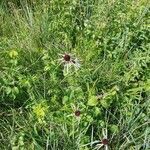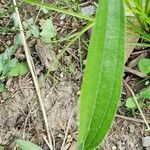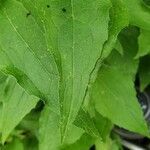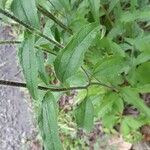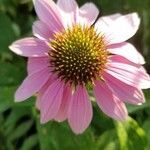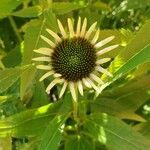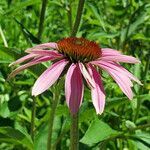Stems clustered on a strong taproot, usually simple; herbage coarsely spreading-hirsute; lvs entire or nearly so, basally disposed, elongate and narrow, the blade to 20 × 4 cm, mostly 5–20 times as long as wide (or the basal a little wider), tapering to the petiole; disk 1.5–3 cm wide; rays pink, varying to purple or white; 2n=22, 44. Dry, open places, especially on the prairies and plains; e. Mont. to Tex., e. to Wis., Ill., Ark., and La., and irregularly, mainly as an intr., to Mich., N.Y., N.C., and Ga. Var. pallida, the more eastern segment of the sp., the principal phase in our range, is mostly tetraploid and robust, 4–10 dm, with drooping rays mostly 4–8 cm, and typically with white pollen. (E. simulata McGregor, of se. Mo., ne. Ark., s. Ill., and w. Ky., diploid with yellow pollen, otherwise as var. pallida, should perhaps be recognized as another var.) Var. angustifolia (DC.) Cronquist, the more western segment of the sp., is diploid and smaller, mostly 1–5 dm, with spreading to drooping rays 2–4 cm, and yellow pollen. (E. angustifolia) An eastern outlier of var. angustifolia, in the cedar glades of c. Tenn., has been called E. tennesseensis (Beadle) Small.
More
Plants to 140 cm (roots fusiform to narrowly turbinate, usually branched). Herbage sparsely to densely hairy (hairs spreading, ca. 1.5–1.7 mm). Stems green to purplish (rarely branched). Basal leaves: petioles 5–20+ cm; blades (1-), 3-, or 5-nerved, elliptic to lanceolate, 12–40 × 1–4 cm, bases cuneate to attenuate, margins entire (usually ciliate). Peduncles 15–50 cm. Phyllaries lanceolate to ovate, 7–15 × 1–3 mm. Receptacles: paleae 9–14 mm, tips purple, usually incurved, sharp-pointed. Ray corollas pink to reddish purple, laminae reflexed, 40–90 × 3–4 mm, sparsely hairy abaxially. Discs conic to hemispheric, 20–40 × 25–37 mm. Disc corollas 5.5–6.7 mm, lobes usually pink to purple (pollen usually white, rarely lemon yellow). Cypselae tan or bicolored, 2.5–5 mm, faces ± smooth, usually glabrous; pappi to ca. 1 mm (major teeth 0–4). 2n = 22.
Dry soils on prairies and barrens. Sandy open woods and prairies in Texas. Rocky prairies, open wooded hillsides, and glades; at elevations from 50-1,500 metres.
